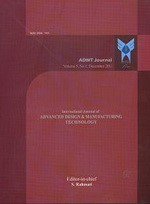-
-
List of Articles
-
Open Access Article
1 - Design, Modeling and Adaptive Force Control of a New Mobile Manipulator with Backlash Disturbances
Hami Tourajizadeh Samira Afshari -
Open Access Article
2 - Vibration based Assessment of Tool Wear in Hard Turning using Wavelet Packet Transform and Neural Networks
vahid pourmostaghimi Mohammad Zadshakoyan Morteza Homayon Sadeghi -
Open Access Article
3 - Comparative Study and Robustness Analysis of Quadrotor Control in Presence of Wind Disturbances
Reham Mohammed -
Open Access Article
4 - Vibration Suppression of Grass Trimmer Handle using Tunable Vibration Absorber
Sushil Sahebrao Patil -
Open Access Article
5 - Free Vibration of Functionally Graded Epoxy/Clay Nanocomposite Beams based on the First Order Shear Deformation Theory
Mahdi Karami Khorramabadi -
Open Access Article
6 - A New Robust Strategy to Improve the Transient Dynamic of a Vehicle
Mohammad Amin Saeedi -
Open Access Article
7 - Effect of Aerodynamic Blade Change of Two-Stage Axial Subsonic Turbine on Design Point
Mahmood Adami Behrooz Shahriari Ali Zamani Gharaghoushi -
Open Access Article
8 - Determination of Material Properties Components used in FEM Modeling of Ultrasonic Piezoelectric Transducer
Abbas Pak -
Open Access Article
9 - Fatigue Crack Growth in Thin-Wall Pipes Subjected to Bending
MohammadMahdi Amiri -
Open Access Article
10 - Comparison of Neural Networks and Fuzzy System for Estimation of Heat Transfer Between Contacting Surfaces
Shayan Fathi Mohammad Eftekhari Arman Adamian -
Open Access Article
11 - Micro Wire Electrical Discharge Machining of MEMS Structures with Optimized Dimensional Deviation
Mohammad Tahmasebipour Younes Tahmasebipour Ali Vafaie -
Open Access Article
12 - Implementation of the Quasi-Brittle Damage Model for 2024 Aluminum Alloy under Periodic Loading
Sadegh Ghorbanhosseini saeed yaghoubi -
Open Access Article
13 - Experimental Study on Manufacturing of Tailor Friction Stir Welded Aluminium Blanks
Farhad Teimouri Hamid Montazerolghaem Mahmoud Farzin
-
The rights to this website are owned by the Raimag Press Management System.
Copyright © 2021-2025







